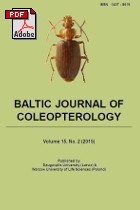Different responses of epigeic beetles to heavy metal contamination depending on functional traits at the family level
Main Article Content
Abstrakt
Beetles are the most diverse group of animals in the world, with various functions in all types of terrestrial ecosystems. The aim of the paper was to propose a simple method for evaluating the functioning of forest ecosystems on the basis of changes in life traits of beetles along a gradient of heavy metal contamination. A total of 16 families of beetles (14,142 individuals) were recorded in 18 sample-sites (rows of pitfall traps), along a zinc-contamination gradient (166-3,957 mg/kg dw). NMDS ordination analysis based on the Bray-Curtis coefficient indicated a tendency towards differentiation of beetle families between contamination levels (ANOSIM comparison). SIMPER analysis showed that three groups (Geotrupidae, Carabidae and Silphidae) were more abundant in the reference sites than the polluted sites, whereas Curculionidae, representing herbivores, and small predators of the Staphylinidae family were more abundant on heavily contaminated sites. A generalized linear model showed that pollution class and season were responsible for most of the variation in family abundance. Geotrupidae were most sensitive to contamination. Their occurrence on heavily contaminated sites was extremely low and seemed to have resulted from random colonisation from other regions. Our results indicated that beetles at the family level are good indicators of heavy-metal concentration. Their appearance reflects both direct and indirect effects of heavy metals. They can accumulate a large amount of pollutants that reduce their survival rate and may also be good indicators of ecological processes such as impoverishment of food-web chains and reduced decomposition rates. Beetle abundance at the family level underscores the usefulness of these organisms in heavy-metal monitoring. Moreover, simple methods of sampling and taxonomic identification as well as variation in life traits along a disturbance gradient, make it possible to obtain valuable information on the condition of forest ecosystems contaminated with heavy metals.
Article Details
Statystyki
Downloads
Download data is not yet available.
Rekomendowane teksty
